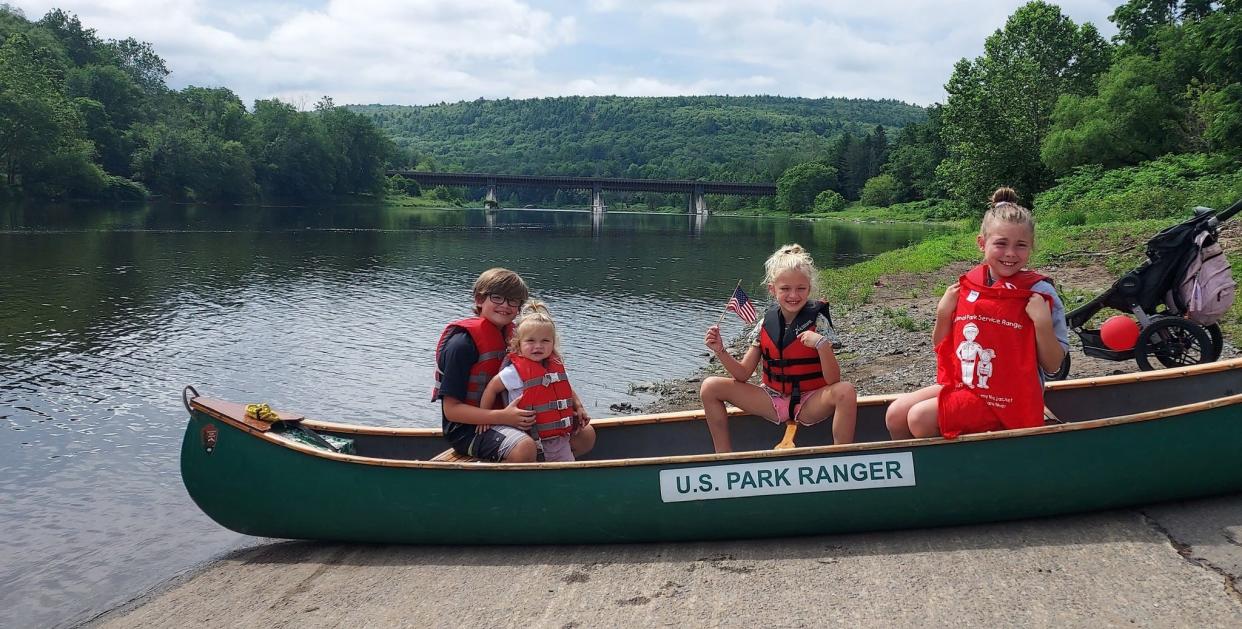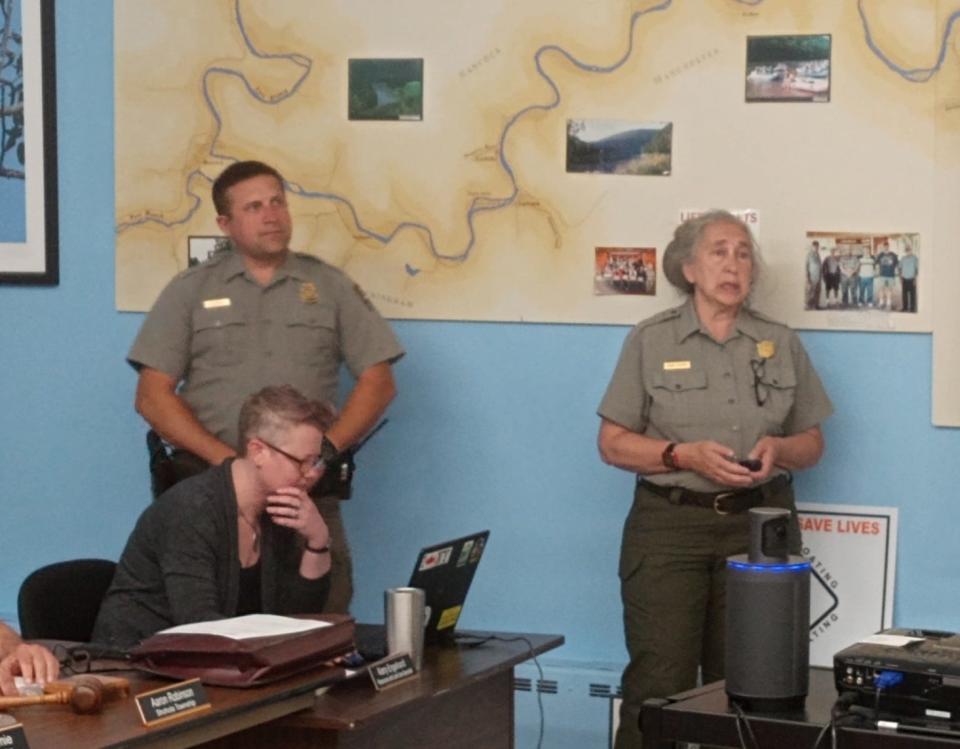Upper Delaware River: About half wearing life jackets; one drowning so far in 2023

Vigorous efforts to persuade visitors on the Upper Delaware River to wear life jackets for their own protection continue unabated, with a recent drowning incident marking the 78th since the National Park Service (NPS) arrived here in 1980. Statistics are showing the message may be getting across.
The national average of adults wearing a personal flotation device (PFD), commonly called a life jacket, was 19.5% in 2021, stated Ingrid Peterec, chief of interpretation, Upper Delaware Scenic & Recreational River (UPDE)/ NPS. On the Upper Delaware, the statistic for 2022 was almost 52%. That is close to the average for the past 10 years (54.89%).
She and Ron Babus, a law enforcement ranger, representing the Water Safety Committee, discussed their latest efforts with the Upper Delaware Council (UDC) July 6 in Narrowsburg, New York.
"This is important to us. We've been doing this since 2011. We partner with the U.S. Coast Guard," she said. Park Service personnel and volunteers collect their data by "sitting under a tree" and recording the type of vessel going by, gender of each occupant, whether they are wearing life jackets and the river height. She said this data helps the NPS know if they are doing the job they need to do.
Peterec said the 52% rate shows people are trying to wear life jackets. In 2022, over 3,800 observations were collected of river traffic. Volunteers to help with this are welcome, she said.

The Park Service partners with other organizations and agencies on this committee, including the UDC, Pennsylvania Fish & Boat Commission and New York Department of Environmental Conservation.
There were three drownings in 2022 and five in 2021.
There has been one drowning in 2023 to date, in May. Fortunately, there were no drownings over the busy Fourth of July holiday weekend on the UPDE.
Related: NPS stresses importance of life jackets after first drowning of season on Upper Delaware
From 2021: Four drownings in two weeks in the Upper Delaware
In every drowning incident, the victim was not wearing a life jacket. Babus said, "They go on a boating trip, they get hot, they take their life jacket off to go for a swim and end up having trouble."
The river might look calm and the level low, but the Delaware is very unpredictable with swift currents and steep drop-offs.
Alcohol and drugs, he said, are a frequent contributing factor to people making poor judgements and risking drowning.
Billboards with a PFD message went up on Pennsylvania Route 6 and Pennsylvania Route 652 last year, and this year one went up on New York Route 97, facing the Roebling Bridge.
UPDE has also developed a video with a ranger promoting life jackets. The video will be shared with river liveries, and on the UPDE and UDC websites. Pocono Mountain Television Network assisted in making the video. They also use lawn signs and posters.
Peterec said that drowning victims are often young males. She said they think they are invincible, but their families and friends are affected too if something happens. "We really wanted to bring it home," Peterec said, by including in their messaging, "Wear it for your family," etc.
Signs are printed in English, Spanish and Russian, the most common languages of their river visitors.
There are five life jacket loaner stations the NPS makes available, and Peterec said most people return them. The NPS also has some they hand out on the river; the return rate is not as high. Peterec said their hope is that even if visitors do not return a life jacket, it is being worn elsewhere.
UPDE patrols 73.4 miles of the river, from just below Hancock, New York, to just north of Millrift, Pennsylvania, in Pike County. With limited staff, the Park Service is assisted by the volunteer National Canoe Safety Patrol. Babus said they have 70-80 members, patrolling dangerous sections of the river. This allows NPS to patrol more areas of the river. There were around 18-20 volunteers assisting over the July 4 holiday.
"We had a lot of eyes out there," Babus said. Help was rendered to people without experience who capsized their boats in the rapids. "We get them back in the boat, situate them and get them going again, if they want to continue," Babus said.
In 2022, the National Canoe Safety Patrol made 10,815 contacts on the Upper Delaware. Volunteers assisted with 146 rescues and 88 capsized boats. They made 24 calls to NPS rangers. July was the busiest month, with 4,986 contacts, 66 rescues, 40 capsized boats and eight calls to NPS.
NPS meets each morning, usually at Zane Grey Museum, to discuss what areas of the river are expected to be particularly busy that day and where to concentrate patrols.
When contacting people recreating on the river, they are advised to wear a life jacket, and a check is made to ensure they have PFDs on board. Coast Guard-approved PFDs must be available for each person and must be of the right size. Children aged 12 and younger are required to wear one while boating. Inner tubes are considered vessels.
"This is the Park Service at its best," Aaron Robinson, UDC chairperson, said. "When you look at the statistics, it's troubling to see the fatalities, but you wonder how many lives have been saved. You can't calculate that. It's just an investment on lives."
How to avoid drowning
The Upper Delaware Scenic & Recreational River describes what factors can lead to drowning in the river, and what can be done to prevent it.
Boating, alcohol don't mix
"It is important to remember that boating and alcohol don’t mix," the UPDE states, noting that alcohol can impair decision making and response time in an emergency situation. "Think twice about boating under the influence."
Hidden river dangers
Many people enjoy swimming or wading in the river but are unaware of the dangers. Sudden drop-offs, deep holes, and swift currents are typical of the Upper Delaware River. Most drownings in the Upper Delaware River occurred while swimming.
Never swim alone and do not try to fight the current. If you step into deep water, float with the current until you are able to swim toward the shore. A life jacket, throw line, and first aid kits are recommended. The Delaware River is unpredictable and rocks in the river and along the bank are slippery. Walk carefully and wear protective footwear.
Proper fitting
Always wear a properly fitted life jacket. All vessels on the Upper Delaware are required to have a readily accessible, wearable, Coast Guard approved life jacket for each person on board. Inner tubes are considered vessels on the Upper Delaware and require life jackets. Children 12 and under are required to wear their life jackets when boating on the river. When wearing a life jacket, it is important to make sure it is properly fitted and secured.
Don't tie it up
Never tie a life jacket into a vessel. A life jacket tied to a boat cannot save your life.
If your boat capsizes, be ready to help yourself. Keep upstream of the craft; float on your back with your feet forward and close to the surface to fend off any rocks. Never stand up in fast-moving water; your feet or legs could become trapped, allowing the current to push you under. Release your boat only if it improves your safety. A canoe, even filled with water, is a good floatation device, but be sure to stay upstream of your vessel. The force of the water can easily pin a person between their vessel and a river obstacle.
Check conditions
Before you go out into the Upper Delaware River, find out what to expect by calling the River Information Hotline: 845-252-7100. This recording is updated daily with reports of air and water temperatures, and river heights.
High river alerts are available through the U.S. Geological Service at waternow@usgs.gov. Visit their site to find the river gauge on the Upper Delaware from which you wish to receive alerts. Automated alerts will be sent to your smartphone.
River conditions may be checked online at water.weather.gov/ahps/region.php?state=pa.
See also: nps.gov/upde/planyourvisit/safety.htm.
Instagram: #UpperDelaware #LifeJacketsSaveLives
This article originally appeared on Tri-County Independent: NPS urges life jacket use on Upper Delaware River

